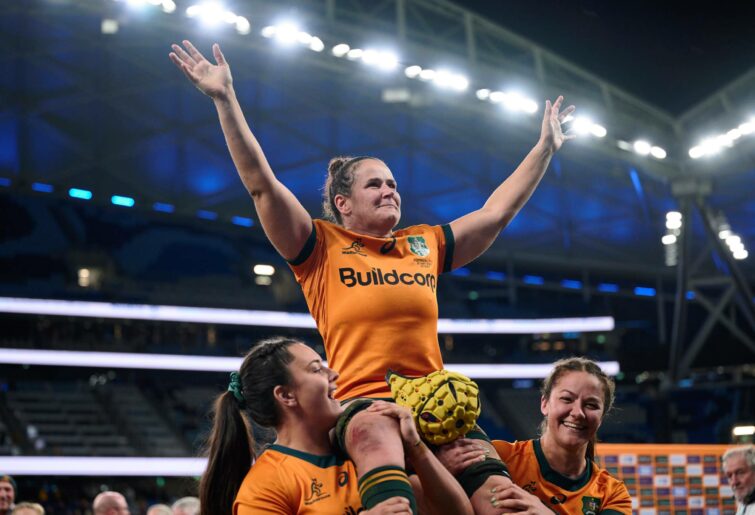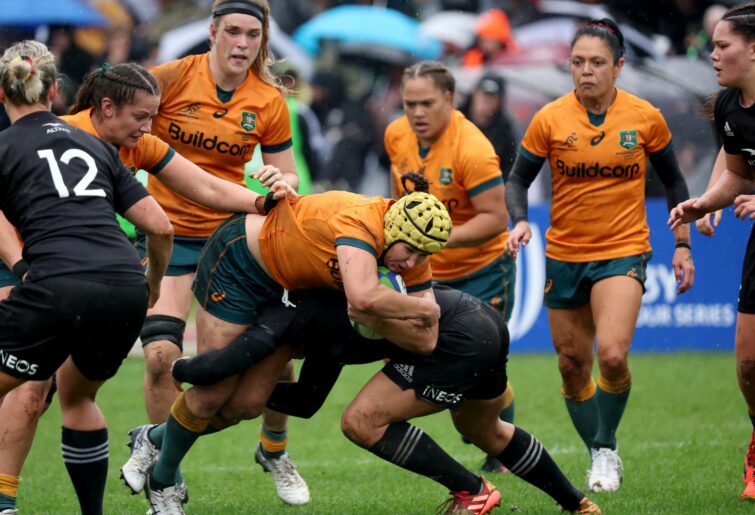Things could be worse for Australia’s Wallaroos. Imagine Rugby Australia president Joe Roff going the full pash, or coach Jay Tregonning the breast grope, like their Spanish soccer counterparts, Luis Rubiales and Jorge Vilda.
Things could also be a lot better. At least the Spanish players have a World Cup win to celebrate. At last year’s Women’s Rugby World Cup, the Wallaroos were thrashed 41-5 in their quarter-final, and currently sit fifth in the world rankings, with a chasm between them and the ‘big four’: England, New Zealand, France and Canada.
In the year since, things haven’t got any better — on the field or off it.
With Australia swept up in the Women’s FIFA World Cup, courtesy of the Matilda’s semi-final run, that excitement brought with it inevitable demands for increased funding for the sport. Along with that, it was only natural there be questions around implications for other sports, and a taking stock of the differences.
Some of the comparisons with rugby are staggering. The Australian Financial Review estimates that Matildas marquee player, Sam Kerr, earned $3.34m last year. Her long-range semi-final belter against England will only have added more zeroes to the end of that number.

Matildas captain Sam Kerr. (Photo by Ryan Pierse/Getty Images)
Other squad members are paid modestly by comparison, but even so, earn in the hundreds of thousands of dollars annually. It is money Australia’s elite women rugby players can only dream of.
Is that fair? Well, no, if one’s viewpoint is that life should be fair, or that nobody who plays sport deserves to be paid multiples more than critical healthcare workers, teachers or ‘insert other worthy occupation here’.
In the context of professional sport however, it’s perfectly fair. Which is the nub of Rugby Australia’s problem. And because of that, it’s a huge problem for the Wallaroos players.
The Women’s World Cup generated just under $900m in revenue for FIFA. After allowing for staging costs, and the ferrying of FIFA executives around the globe to sample the delights of potential locations for future events, even the most modest of trickle downs will help swell Football Australia’s coffers.
Add in $300m committed by federal and state governments before the event, another $200m afterwards, and Football Australia about to take the Matildas’ broadcast rights to the market, and you get the picture.
In professional sport, participants get paid through individual contracts, prize money or sponsor deals – basically what somebody or some entity is willing to pay. A TV network here, a Russian oligarch there, the Saudi Government everywhere.
When it comes to those rivers of cash, one problem for the Wallaroos is that there are already five professional team sports in the queue ahead of them: soccer, rugby league, Australian rules football, cricket and netball.

The Wallaroos. (Photo by Andrea Cardin – World Rugby/World Rugby via Getty Images)
A second problem – the straw that broke the camel’s back last week, and which precipitated the release of a letter penned by players to Rugby Australia – is that, even if Australia’s women rugby players understand that their sport is a fiscally bereft cousin of other women’s sports, nobody likes being reminded they are treated as second-class citizens by their own administration.
Rugby Australia can’t pay women players with money it doesn’t have. But rugby has always trumpeted the one benefit sports like Australian rules football and rugby league can’t deliver; the ability to wear the green and gold in genuine international competition, including events like World Cups and the Olympic Games. It is all the more important then, that Rugby Australia harness this advantage.
That’s why it was galling to hear ex-Wallaroo Grace Kemp describe her experience of playing at last year’s World Cup as just like playing “club rugby”, going on to add, “we travelled with no media, we didn’t have any social media posts put up about our game, hardly anyone knew we were playing. Even our training kit was in men’s sizes.”
Now at the Canberra Raiders in the NRLW, Kemp says, “I have seen what a professional athlete can be.” Part of her discontent, no doubt, relates to money. But part of it speaks to what kind of organisation Rugby Australia is, as opposed to what it says it wants to be.
If there was any notion that, because of short seasons that don’t overlap, rugby could allow players free passage back and forth, using the NRLW as a second tier professional competition by stealth, that has now been put to bed.
The opportunity to play more games in the NRLW, in a more visible competition, and to be well paid doing it, will only result in more players like Kemp not coming back to rugby.
So, what levers does Rugby Australia have at its disposal, to cauterise this wound? In any crisis the first task is always damage control, which explains why a sudden press release zinged out of Moore Park HQ heralding the appointment of Jaime Fernandez as new High Performance Women’s Manager (co-funded with World Rugby), and the promise of a full-time coach for the Wallaroos in 2024.
It was the same desire to flood space that saw the release of an announcement to signal a future announcement – straight out of the ABC’s ‘Utopia’ Nation Building Authority – referencing plans to centralise Australia’s professional rugby operations.
With scant detail provided, the story behind that is another important discussion for another day. But given its dubious track record, envisaging how Rugby Australia might effectively operate professional rugby across five franchises, men and women, as well as its national sides, requires quite a leap of faith.
CEO Phil Waugh calmed things further, meeting with players later in the week, effectively buying time for the ruling body. But, ‘time to do what?’ remains the $64m question.
There is a misplaced sense in pockets of the AFLW and some other women’s sports, that just because sports announce themselves as professional, they are duly entitled to the same spoils that other sports, or the male version of their own sport, enjoy.
Nobody – least of all the Wallaroos themselves – is calling for Australian women players to be paid the same, or afforded the same playing schedule as the Wallabies.
But when inequity stretches into women players making material sacrifices that effectively subsidize not only the business class travel of male players and officials, but also that of their wives and girlfriends, that’s another thing altogether.
On that specific matter, Rugby Australia is still to clarify what was paid for, by whom, to whom. But no matter the detail, no matter that Rugby Australia wants to do everything in its power to support the Wallabies’ World Cup campaign, there are disparities too big to ignore.
Yes, all of the arguments about putting the cart before the horse, and women’s rugby needing to prove first that it can generate revenue off its own bat, apply. But only if that’s how you see the world; the worth of everyone and everything being a direct component of their output.

Shannon Parry of the Wallaroos. (Photo by Brett Hemmings/Getty Images)
Just like a builder takes on an apprentice chippie, or venture capital firms hand millions of dollars to start-up tech companies to develop their businesses, there are things that are worth investing in from the ground up. Before they blossom, to help them grow, so that they can blossom.
The improvement in Australia’s Super W competition this year, compared to 2022, was marked. But everything is relative. Just as the AFLW has found, it is problematic to take girls and women out of jobs and school, give them a short, five-match season plus finals, and expect this to be sufficient to deliver the conditioning and skills that will draw paying customers through the gate in numbers.
It is also grossly insufficient for Australia to keep pace with their international competitors.
England, France and New Zealand have advanced because two of those countries have the cash and the population to underpin making their top tier players professional. For the other, setting aside the All Blacks’ capitulation at Twickenham over the weekend, it is a national imperative that any team that takes the field wearing black with a silver fern, is properly competitive.
A sport that provides an interesting counterpoint for Australian rugby, is netball. Australia’s Diamonds are newly crowned world champions, and the domestic Super League is undeniably elite level.
This year’s grand-final, which I attended, was won by the Adelaide Thunderbirds over the Sydney Swifts 60-59, after extra-time, and was full of drama, fast movement and high skill. Community and junior participation levels remain high.
Netball also benefits from not being framed in the context of a male version, like the football codes and cricket, are constantly subjected to.
Yet despite all of this, Australian netball splutters along, chronically short of the cash it needs to grow its professional league and pay its top players what they really think they are worth.
Not only that, with a $15m sponsorship deal scuppered by its own players, Netball Australia found replacement funding from the VIC state govt, only for CEO Kelly Ryan, in the manner of a hostage video, to be forced into make a grovelling statement in support of premier Daniel Andrews’ decision to cancel the Commonwealth Games.
This despite netball – a truly Commonwealth sport – being one of the biggest losers from the decision.
Clearly, it’s a tough road for any woman’s sport in Australia, let alone one like rugby, just starting its professional journey. Long-term sponsors like Buildcorp are highly valued and appreciated, but the main reason why Rugby Australia has sat on its hands with women’s rugby is because the whole game is chronically underfunded and thus under-resourced.

(Photo by Andy Jackson/Getty Images)
It provides no satisfaction for this column to say it was warning of the consequences of Rugby Australia missing the boat, as far back as the 2017 Women’s World Cup. Together, the FIFA Women’s World Cup and the Wallaroos have forced Rugby Australia’s hand, and ultimately, that is no bad thing.
But no matter the embarrassment and hand-wringing of the last week, the message Waugh would have given the Wallaroos is that, while some of the optics and pain points can and will be tidied up, it won’t be until after the private equity tooth fairy arrives that any meaningful progress can be made.
Not because this money is a convenient crutch, but because this is precisely what an equity injection should be used for; to identify and source new raw material, to enhance the product offering, to develop new markets.
Time however, is of the essence. Australia has already fallen well behind its international and domestic competitors. Its home World Cup in 2029 will come around quickly.
In the meantime, the game won’t be able to sustain another six years of middling performance and frustrated players, all on the off chance that the Wallaroos will go on a tear and capture the imagination of the Australian public.
Real investment will be required, as will an authentic desire on the part of Rugby Australia to back words with actions.
It is ironic that in pointing to disparities with the men’s game to make their point, the Wallaroos actually highlight how the root causes of their problem are exactly the same flaws that impede men’s rugby; not enough money and an unbalanced, dysfunctional domestic structure.
And with no fundamental fix in sight, that is why, no matter what olive branches are offered to quell the current discontent, Rugby Australia’s women problem isn’t going away any time soon.
































































































